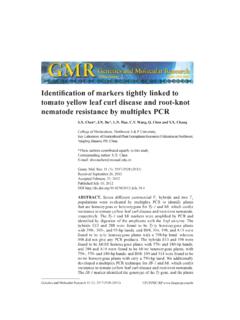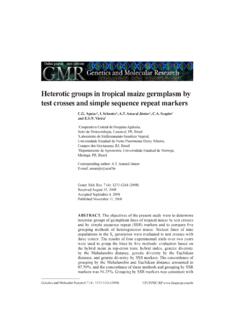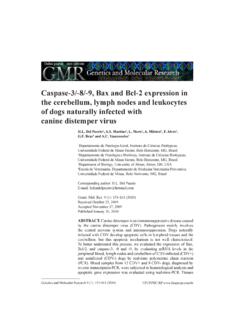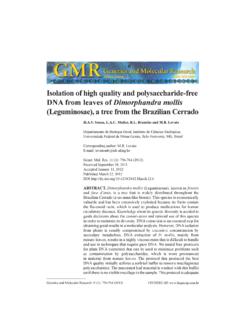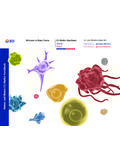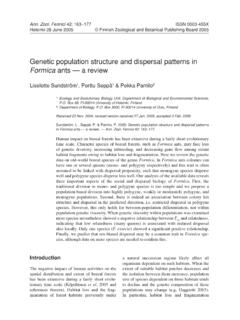Transcription of Hypoxia enhances periodontal ligament stem cell ...
1 Genetics and Molecular Research 15 (4): gmr15048965 Hypoxia enhances periodontal ligament stem cell proliferation via the MAPK signaling pathwayY. He1,2, Jian2, Zhang1,3, Y. Zhou1, X. Wu1, G. Zhang1 and Tan11 Department of Oral and Maxillofacial Surgery, Second Affiliated Hospital, Third Military Medical University, Shapingba District, Chongqing, China2 Department of Stomatology, PLA General Hospital of Chengdu Military Region, Chengdu, Sichuan Province, China3 Department of Stomatology, 457th Hospital of PLA, Wuhan, Hubei Province, ChinaCorresponding author: TanE-mail: Mol. Res. 15 (4): gmr15048965 Received July 13, 2016 Accepted September 5, 2016 Published November 21, 2016 DOI 2016 The Authors. This is an open-access article distributed under the terms of the Creative Commons Attribution ShareAlike (CC BY-SA) There is high incidence of periodontal disease in high-altitude environments; Hypoxia may influence the proliferation and clone-forming ability of periodontal ligament stem cells (PDLSCs).
2 The MAPK signaling pathway is closely correlated with cell proliferation , differentiation, and apoptosis. Thus, we isolated and cultured PDLSCs under hypoxic conditions to clarify the impact of Hypoxia on PDLSC proliferation and the underlying mechanism. PDLSCs were separated and purified by the limiting dilution method and identified by flow cytometry. PDLSCs were cultured under hypoxic or normoxic conditions to observe their cloning efficiency. PDLSC proliferation at different oxygen concentrations was evaluated by MTT 2Y. He et and Molecular Research 15 (4): gmr15048965assay. Expression of p38/MAPK and MAPK/ERK signaling pathway members was detected by western blotting. Inhibitors for p38/MAPK or ERK were applied to PDLSCs to observe their impacts on clone formation and proliferation . Isolated PDLSCs exhibited typical stem cell morphological characteristics, strong abilities of globular clone formation and proliferation , and upregulated expression of mesenchymal stem cell markers.
3 Stem cell marker expression was not statistically different between PDLSCs cultured under Hypoxia and normoxia (P > ). The clone number in the Hypoxia group was significantly higher than that in the control (P < ). PDLSC proliferation under Hypoxia was higher than that of the control (P < ). p38 and ERK1/2 phosphorylation in hypoxic PDLSCs was markedly enhanced compared to that in the control (P < ). Either P38/MAPK inhibitor or ERK inhibitor treatment reduced clone formation and proliferation . Therefore, Hypoxia enhanced PDLSC clone formation and proliferation by activating the p38/MAPK and ERK/MAPK signaling words: Hypoxia ; periodontal ligament stem cells; Cell proliferation ; Clone formationINTRODUCTIONP eriodontitis is one of the most common periodontal diseases. As the main cause of adult tooth loss, periodontitis is characterized as the lack of periodontal support tissue (Hackett and Roach, 2001; Dumitrescu, 2016).
4 Periodontitis has a relatively high incidence; 46% of Americans exhibit chronic periodontitis (Eke et al., 2015), and the incidence is even higher in developing countries (Corbet, 2006). China exhibits a high incidence of periodontal disease; 80-97% of adults are affected (Wu et al., 2015). periodontal health has therefore become a global health recent years, tissue engineering repair technology based on the theory of pluripotent cells in periodontal tissue became a hot spot in treating periodontal ligament disease. As an important component of periodontal tissue, periodontal ligaments (PDLs) play a critical role in maintaining the integrity of periodontal tissue (Somerman et al., 1990). PDLs maintain self-renewal and repair capabilities through the function of PDL cells (Trubiani et al., 2016). Numerous evidence demonstrated that stem cells in the PDL are the reason for periodontal tissue regeneration. In 2004, Seo et al. (2004) identified periodontal ligament stem cells (PDLSCs) from periodontal tissue and proposed this concept for the first time.
5 PDLSCs promote the development of tissue engineering because of their characteristic clone-forming ability, proliferation , and pluripotent stem cell differentiation potential (Mattioli-Belmonte et al., 2015; Vandana et al., 2015).However, the function of PDLSCs is regulated by various factors, including external stimuli and immune status. Many epidemiological studies reported that the incidence of periodontitis in residents living in areas with altitudes over 4000 meters was significantly higher than that in residents living at sea level (Jian et al., 2014). Animal experiments also revealed that Hypoxia may induce severe periodontitis (Xiao et al., 2012; Terrizzi et al., 2013). The abovementioned evidence showed that hypoxic microenvironments may contribute to 3 Hypoxia promotes PDLSC proliferationGenetics and Molecular Research 15 (4): gmr15048965periodontal cells inability to regenerate. Furthermore, a previous study also demonstrated that exposure of PDLSCs to Hypoxia affected their osteogenic potential, mineralization, and paracrine release (Wu et al.)
6 , 2013). However, whether Hypoxia exerts an effect on PDLSC proliferation remains poorly understood. Thus, we speculated that Hypoxia may obstruct the self-renewing ability of PDLSCs. In this study, we clarified the impact of Hypoxia on PDLSC proliferation and clone formation by isolating PDLSCs and cultivating them under mitogen-activated protein kinase (MAPK) signaling pathway is one of the most important biological signaling pathways. Its activation regulates a variety of cellular behaviors such as cell proliferation , differentiation, and apoptosis. The MAPK signaling pathway, including members p38 and ERK, plays a key role in the ability of bone marrow mesenchymal stem cells to differentiate into osteogenic cells (Jaiswal et al., 2000; Liu et al., 2009), and is related to cell self-renewal (Wang et al., 2016; Xu et al., 2016). Hypoxia can activate the p38/MAPK and MAPK/ERK signaling pathways (Qiu et al., 2016). Therefore, this study explored the impact of Hypoxia on PDLSC self-renewal and related mechanisms, by regulating the expression and activity of p38/MAPK and MAPK/ERK signaling pathway-related AND METHODSMain instruments and reagentsDMEM medium was obtained from Gibco.
7 Fetal bovine serum was obtained from Every Green Co., Ltd. (China). Penicillin-streptomycin was obtained from Hyclone. PBS was obtained from ZSbio. Type II collagenase and MTT were obtained from Sigma. PE-labeled STRO-1, CD146, CD44, and CD45 antibodies were obtained from Bioscience. RIPA lysis buffer was obtained from Beyotime. BCA protein quantification kit was from Shanghai Shengneng Bocai Co., Ltd. HRP-labeled mouse anti-human GAPDH monoclonal antibody was obtained from KangChen. Protein marker was obtained from Tiangen Biotech Co., Ltd. PVDF membranes were obtained from Millipore. The FC 500 MPL flow cytometry system was from Beckman. The automatic model 680 microplate reader was from Bio-Rad. X-ray film was from Fuji. The dental X-ray machine 2200 was from Eastman Kodak. Vertical electrophoresis apparatus E5889 was from Sigma. The 3111 water jacketed CO2 incubator was from PDLSC isolation and cultivationThe third molar from 15 healthy donors (Han Chinese nationality) with a median age of 39 years (range: 18-56 years) received dental orthodontic treatment in the Second Affiliated Hospital, Third Military Medical University.
8 The tissue was washed with PBS containing penicillin-streptomycin and periodontal tissue was isolated from the root of tooth. The tissue was cut with sterile scissors to a size of 1-3 mm and placed to a centrifuge tube. After centrifugation at 1200 rpm for 5 min, the tissue was treated with type II collagenase and oscillation-digested in a 37 C constant temperature water bath for h. Next, the tissue was filtered through a 70- m mesh and centrifuged at 1000 rpm for 5 min to prepare a single cell suspension. The cells were washed in DMEM supplemented with 10% FBS and penicillin-streptomycin three times and seeded in cell culture dishes at 1 x 104 cells/mL. Cells were cultured at 37 C and 5% CO2 and medium was changed every 3-5 days. All donors gargled 4Y. He et and Molecular Research 15 (4): gmr15048965with chlorhexidine before tooth extraction. Preoperative X-rays showed no dental caries, periodontal disease, bone absorption, or root lesions.
9 The experiment was approved by the Ethics Committee of Second Affiliated Hospital, Third Military Medical University, and informed consent was obtained from all cytometryPDLSCs were seeded on six-well plates at 1 x 106 cells/well and then were assigned to Hypoxia or normoxia groups. Cells in the Hypoxia group were incubated in 37 C, 5% CO2, and 5% O2, whereas the cells in the normoxia group were maintained in 37 C, 5% CO2, and 20% O2. The cells were digested with trypsin when the confluency reached 80% and were then resuspended at 1 x 106 cells/mL. PDLSCs in 100 L PBS were stained with 5 L PE-labeled antibodies against STRO-1, CD44, CD45, and CD146, and then incubated at 4 C in the dark for 30 min. After centrifugation at 2000 rpm for 5 min, cells were resuspended in 500 L PBS and analyzed by flow cytometry. All experiments were repeated at least three assayCell proliferation was detected by an MTT kit (Sigma, St. Louis, MO, USA) according to the manufacturer protocol.
10 PDLSCs were seeded on 96-well plates at 5 x 103 cells/well and incubated under Hypoxia or normoxia. After intervention, 20 L MTT at 5 mg/mL was added to each well and the plate was incubated at 37 C for 3 h. Finally, the plates were treated with 150 L DMSO to resolve the crystals, and optical density at 570 nm was read. The experiments were repeated at least three formation assayPDLSCs were seeded on six-well plates at 1 x 106 cells/well and subjected to either Hypoxia or normoxia. The cells were digested with trypsin and washed with PBS three times. Next, cells were seeded on 96-well plates at different concentrations (1 x 104, 1 x 103, and 1 x 102 cells/well). After 14 days of culture, the cells were fixed in 10% methanol and stained with crystal violet. Then, cell clones was observed under the microscope. Clones containing more than 50 cells were considered positive. Cloning efficiency = clone number / seeded cell number x 100%.

